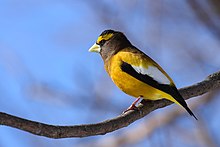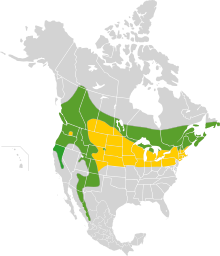| Evening grosbeak Temporal range:
| |
|---|---|

| |
| Male evening grosbeak in Cap Tourmente National Wildlife Area, Quebec | |
| Call | |
| Scientific classification | |
| Domain: | Eukaryota |
| Kingdom: | Animalia |
| Phylum: | Chordata |
| Class: | Aves |
| Order: | Passeriformes |
| Family: | Fringillidae |
| Subfamily: | Carduelinae |
| Genus: | Hesperiphona |
| Species: | H. vespertina
|
| Binomial name | |
| Hesperiphona vespertina (W. Cooper, 1825)
| |

| |
| Range of H. vespertina Year-round range Wintering range
| |
| Synonyms | |
|
Coccothraustes vespertinus | |
The evening grosbeak (Hesperiphona vespertina) is a passerine bird in the finch family Fringillidae found in North America.
The evening grosbeak is bulky, with a large bill and short tail, is placed in the genus Hesperiphona by the IOC checklist and the Handbook of the Birds of the World, while the Clements Checklist and the AOS checklist place it in the genus Coccothraustes. Introduced by Charles Lucien Bonaparte in 1850, the genus Hesperiphona originates from Latin and Ancient Greek words meaning "evening" and "cry." The bird has a distinct appearance, with the adult male featuring a bright yellow forehead and body, brown head, and white wing patches, while the adult female has a mainly olive-brown body with greyer underparts and white wing patches.
The evening grosbeak breeds in coniferous and mixed forests across Canada, the western mountainous areas of the United States, and Mexico. Its migration pattern is variable, sometimes reaching as far south as the southern U.S. in winters. These birds forage in trees and bushes, and their diet mainly consists of seeds, berries, and insects. The bird's range has expanded eastward in historical times, likely due to the planting of Manitoba maples and other shrubs near farms and the availability of bird feeders during winter.
- ^ BirdLife International (2018). "Hesperiphona vespertina". IUCN Red List of Threatened Species. 2018: e.T22720702A131500502. doi:10.2305/IUCN.UK.2018-2.RLTS.T22720702A131500502.en. Retrieved 12 November 2021.
